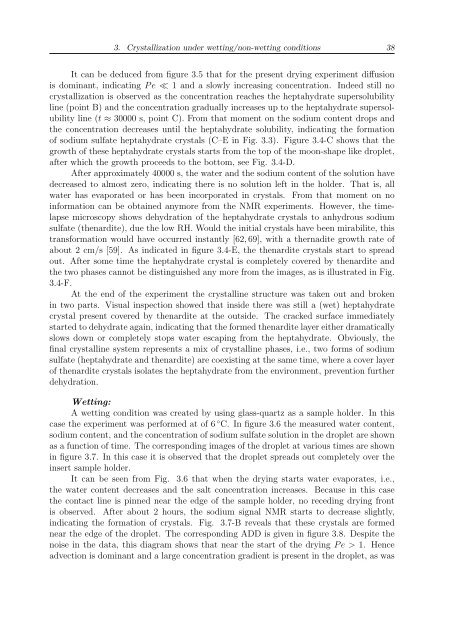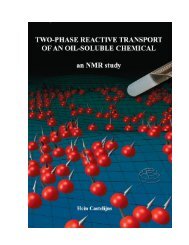P - Technische Universiteit Eindhoven
P - Technische Universiteit Eindhoven
P - Technische Universiteit Eindhoven
Create successful ePaper yourself
Turn your PDF publications into a flip-book with our unique Google optimized e-Paper software.
3. Crystallization under wetting/non-wetting conditions 38<br />
It can be deduced from figure 3.5 that for the present drying experiment diffusion<br />
is dominant, indicating P e ≪ 1 and a slowly increasing concentration. Indeed still no<br />
crystallization is observed as the concentration reaches the heptahydrate supersolubility<br />
line (point B) and the concentration gradually increases up to the heptahydrate supersolubility<br />
line (t ≈ 30000 s, point C). From that moment on the sodium content drops and<br />
the concentration decreases until the heptahydrate solubility, indicating the formation<br />
of sodium sulfate heptahydrate crystals (C–E in Fig. 3.3). Figure 3.4-C shows that the<br />
growth of these heptahydrate crystals starts from the top of the moon-shape like droplet,<br />
after which the growth proceeds to the bottom, see Fig. 3.4-D.<br />
After approximately 40000 s, the water and the sodium content of the solution have<br />
decreased to almost zero, indicating there is no solution left in the holder. That is, all<br />
water has evaporated or has been incorporated in crystals. From that moment on no<br />
information can be obtained anymore from the NMR experiments. However, the timelapse<br />
microscopy shows dehydration of the heptahydrate crystals to anhydrous sodium<br />
sulfate (thenardite), due the low RH. Would the initial crystals have been mirabilite, this<br />
transformation would have occurred instantly [62, 69], with a thernadite growth rate of<br />
about 2 cm/s [59]. As indicated in figure 3.4-E, the thenardite crystals start to spread<br />
out. After some time the heptahydrate crystal is completely covered by thenardite and<br />
the two phases cannot be distinguished any more from the images, as is illustrated in Fig.<br />
3.4-F.<br />
At the end of the experiment the crystalline structure was taken out and broken<br />
in two parts. Visual inspection showed that inside there was still a (wet) heptahydrate<br />
crystal present covered by thenardite at the outside. The cracked surface immediately<br />
started to dehydrate again, indicating that the formed thenardite layer either dramatically<br />
slows down or completely stops water escaping from the heptahydrate. Obviously, the<br />
final crystalline system represents a mix of crystalline phases, i.e., two forms of sodium<br />
sulfate (heptahydrate and thenardite) are coexisting at the same time, where a cover layer<br />
of thenardite crystals isolates the heptahydrate from the environment, prevention further<br />
dehydration.<br />
Wetting:<br />
A wetting condition was created by using glass-quartz as a sample holder. In this<br />
case the experiment was performed at of 6 ◦ C. In figure 3.6 the measured water content,<br />
sodium content, and the concentration of sodium sulfate solution in the droplet are shown<br />
as a function of time. The corresponding images of the droplet at various times are shown<br />
in figure 3.7. In this case it is observed that the droplet spreads out completely over the<br />
insert sample holder.<br />
It can be seen from Fig. 3.6 that when the drying starts water evaporates, i.e.,<br />
the water content decreases and the salt concentration increases. Because in this case<br />
the contact line is pinned near the edge of the sample holder, no receding drying front<br />
is observed. After about 2 hours, the sodium signal NMR starts to decrease slightly,<br />
indicating the formation of crystals. Fig. 3.7-B reveals that these crystals are formed<br />
near the edge of the droplet. The corresponding ADD is given in figure 3.8. Despite the<br />
noise in the data, this diagram shows that near the start of the drying P e > 1. Hence<br />
advection is dominant and a large concentration gradient is present in the droplet, as was
















